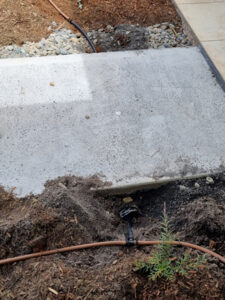
Site assessment
By Patrick Regnault
Each work site has its particularities. Site assessment is a tool we use to design, build, and maintain gardens. By sharpening our observation and our client’s interpretation we can gain a deeper appreciation of the site possibilities and greatly improve our work through efficient scheduling.
The assessment starts as you approach the site, as its setting in its larger environment will have an influence on the design and the cost of the project. Ease of delivery, parking, neighbourhood vibes, and borrowed landscape cannot be ignored. Observing the overall natural and man-made drainage of the area as a whole may impact the configuration of the garden.
If we pay particular attention to the ‘magic three’ – access, light, and gravity, we have already made a major headway into the design and planning. Access to and through the site, the aspect of light through the year in different parts of the garden, and gravity which is by far the most important as it will influence drainage, and also the hardscape and labour costs in the short and long term.

Our observation needs to take into account surrounding buildings and landforms as they have a direct bearing on wind speed and movement. A cooling easterly wind may be deflected by the built environment or topography making the garden stifling in summer, or a site sitting on a ridge may be windy all year round affecting plant selection.
Your work schedule will be more effective by observing traffic patterns in and out of the area to decide the best times for deliveries and work hours. It also helps the operation and planning of the work if we evaluate the site as the work progresses, and make changes as necessary.
Maintenance programs require a productive appraisal of the garden as a whole, including the plants and soil as well as the fauna visiting it. Planning when to prune and when not to prune to avoid disturbing the nests, or when to clean the pond to avoid disturbing the natural balance of plants, fish, frogs, and insects. Will the glass pool fence cause bird casualties or be a constant cleaning nightmare?
As time passes, the garden will evolve, and plants will grow and may overshadow or encroach onto others. The borrowed landscape may change, sometimes drastically, asking the gardener to rethink the garden in small or large parts. Pests and diseases will need to be detected before they cause too much damage and their treatment carried out.
Site assessment goes hand in hand with communication. At first with the owners or the architect, then with employees and subcontractors, and finally back with the owners during the ongoing maintenance. The mastery of a site as a whole, and over a long span of time, helps to pass on to the client the understanding of the garden’s evolution, and what this will entail in cost and labour over what is hoped to be the long life of a garden.
In the teaching of landscape design and ornamental horticulture we need to pass on the understanding that a garden can last for decades. Unless we want the design of short-term and fast gardens in the future, we have to educate the current students to think long term about the gardens – gardens with biodiverse habitats inspire a communion with the ever-changing nature of life.
There is far more to site assessment than is actually taught or done. We can divide it into parts to suit the work but we need to keep in mind the whole picture and have the ability to communicate it to others. By doing so we not only improve our designs and our horticultural knowledge, we also school ourselves in seeing the bigger picture of our work and the impact it will have on people, fauna, and flora.
Patrick Regnault FAIH RH0062
Interactive Landscapes
E: patrickregnault@hotmail.com
Main photo: Glass pool fencing requires regular cleaning (Image: Patrick Regnault)
